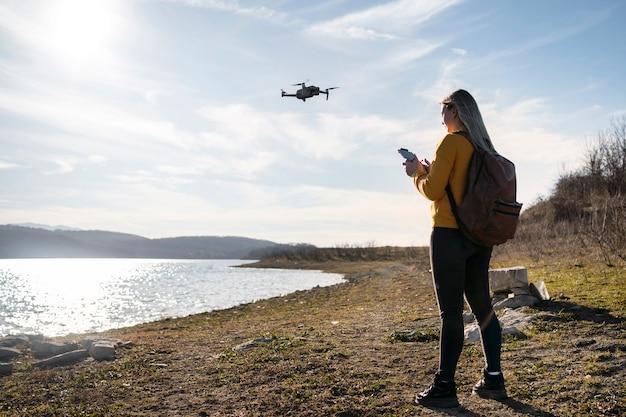Source: Freepik.com
Landscape photography allows us to capture the breathtaking beauty of the natural world. From sweeping mountain ranges to serene coastlines, there’s no shortage of awe-inspiring scenery to explore.
But what if you could elevate your landscape photos and showcase these vistas from a whole new perspective?
UAVs offer a unique opportunity to achieve this, allowing you to capture dramatic aerial shots that were once only possible with helicopters or airplanes.
Let’s get started!
1. Mastering the Basics of Photography:
Before diving into the world of aerial photography, it’s crucial to have a solid foundation in the fundamentals of photography.
Understanding concepts like aperture, shutter speed, ISO, and composition will serve you well when operating a drone. Familiarize yourself with these elements and practice capturing compelling photos on the ground before taking to the skies.
2. Planning Your Shoot:
Successful landscape photography, whether from the ground or with a drone, requires careful planning. Research the location you intend to capture and scout it out beforehand if possible.
Consider factors like the time of day, weather conditions, and potential obstacles that might impact your drone flight.
Aim to shoot during the golden hour, just after sunrise or before sunset, for the most dramatic and vibrant lighting.
3. Choosing the Right Flight Path:
Once airborne with your drone, it’s essential to choose strategic flight paths for optimal composition. Utilize the drone’s maneuverability to your advantage. Experiment with different altitudes, angles, and perspectives to create dynamic compositions.
For instance, following a natural curve in a river or coastline from above can add a sense of depth and flow to your image.
4. Focusing Your Shot for Impact:
Focusing plays a critical role in creating visually compelling landscape photos, and this is especially true when using a drone.
Look for leading lines, foreground elements, and natural frames within the landscape that draw the viewer’s eye into the image. Leading lines, such as a winding road or a riverbank, can guide the viewer’s gaze towards the main subject of your photo.
Foreground elements, like a lone tree or a rock formation, can add depth and context to your aerial shot. By carefully composing your shot with these elements, you can create a more engaging and impactful composition.
5. Editing for Perfection:
Even the most meticulously planned and executed drone photography can benefit from post-processing.
Basic editing tools can help you adjust exposure, contrast, and color balance, while more advanced techniques can be used to remove unwanted elements or enhance specific details in your landscape photos.
Wrapping Up
To become a skilled drone photographer, it is crucial to familiarize yourself with the drone’s features and practice capturing compelling photos on the ground before taking flight. Additionally, strategic planning, choosing the right flight path, focusing your shot for impact, and post-processing are essential steps to achieve visually stunning landscape images. By following these guidelines, you can elevate your drone photography skills and capture breathtaking aerial views that leave a lasting impact on viewers.




